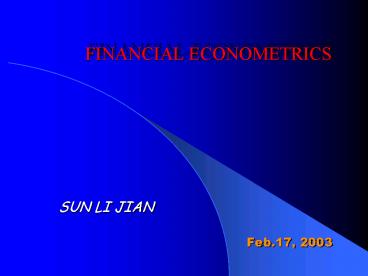FINANCIAL ECONOMETRICS - PowerPoint PPT Presentation
1 / 17
Title:
FINANCIAL ECONOMETRICS
Description:
The nature of the econometric approach. The Process of an econometric analysis ... TSP,SHAZAM,RATS,Eviews. GAUSS,S-PLUS. SPSS,SAS,STATA. Mathematica,Excel ... – PowerPoint PPT presentation
Number of Views:260
Avg rating:3.0/5.0
Title: FINANCIAL ECONOMETRICS
1
FINANCIAL ECONOMETRICS
SUN LI JIAN
- Feb.17, 2003
2
INTRODUCTION
Empirical International Finance
3
Contents
- 1. Models,Data and Process
- The nature of the econometric approach
- The Process of an econometric analysis
- 2. Applications of Financial Econometrics
- Dynamic effects of various shocks
- Empirical finance
- Refining data
- 3. Key Features of Financial Econometrics
- The regression model
- Time series models
- Dynamic model
- Others
- 4. Text and Software
- Text
- Software
4
1. MODELS, DATA AND PROCESS
- The Nature of The Econometric Approach
- structural analysis
- evaluation
- forecasting
- The Process of An Empirical Analysis
- model specification
- structural equations and reduced forms
- parameters conditions
- sampling and refining data
- Identification and estimation
- statistical test
- economic interpretation
5
Econometric Approach
6
Structural Analysis
- Econometric Model
- Linear model
- Greene (2000)
- Nonlinear model
- Davidson Mackinnon (1993)
-
- Static model
- Time series model
- Enders (1995)Mills(1999)
- Dynamic model
- Christian Gourieroux (1997)
- Structure Change (Maddala and Kim,1998)
- Chow test
- Time-varying parameters
7
Evaluation
- The Simulation Approach
- Identification
- Limited-information estimation
- Full-information estimation
- Monte Carlo studies
- Other Approaches
- The Instruments-targets approach
- The Social-welfare-function approach
8
Forecasting
- Forecasting Methods
- Sample information
- Economic theory
- Introduction to Forecasting Techniques
- Time series model (ARIMA,GARCH,KALMAN-filter)
- Statistical model (Monte Carlo techniques,MSFE)
9
Data and Refining
- Type
- Quantitative versus qualitative data
- Time-series versus cross-section data (Panel
Data) - Non-experimental versus experimental data
- Micro versus macro data
- Nature
- Degrees of freedom
- Multicollinearity
- Serial correlation
- Structural change
- Errors in measurement
- Non-stationary (trends, seasonality)
- Non-linearity
- Source
- IMF international financial statistics (CD-ROM)
10
2. APPLICATIONS OF FINANCIAL ECONOMETRICS
- Dynamic Effects of Various Shocks
- Transmission mechanism of financial crisis
- Credit channel of policy
- Empirical Finance
- Forecasting(price of capital assets, risk
premium,etc.) - Predictability of asset returns
- Market microstructure
- Term structure
- Financial integration
- Refining Data
- Missing data
- Base changes (GDP,M1,etc.)
- Nonstationary (EX,IR,etc.)
11
3. KEY FEASURES OF FINANCIAL ECONOMETRICS
- The Regression Model
- The Method of ordinary least squares
- Assumption (disturbance termobservations,
independent variables) - The Gauss-Markov theorem (BLUE,consistency)
- Other methods of estimation
- Maximum likelihood
- Moments
- Bayesian approach
- The Probability distribution for OLS estimator
- Parameters and disturbance term
- t,F,P tests and significance (confidence
intervals) - Applications (structural break,prediction,model
selection) - Extensions
- Diagnosis and treatment
12
- Time Series Models
- Differences between LRM and TSM
- Exogenous variables,sequence,theory
- Components
- Trends
- Seasonality
- Cycle
- Irregularity (convergence)
- Conditional heteroskedasticity (volatility)
- Non-linearity (state dependency)
- Determinants
- Function structure
- Lag order
- Dynamic Model
- Transfer process (impulse response function)
13
Other Useful Financial Econometric Models
- Methods of Instrumental Variables
- GMM
- Discrete and Limited Dependent Variable Models
- Probit,logit and tobit models
- Computationally Intensive Methods
- Monte Carlo methods
- The bootstrap
- Permutation test
- Nonparametric and semiparametric estimation
- Panel Data Analysis
- Survival Data Analysis
- Event-Study Analysis
14
4. TEXT AND SOFTWARE
- Text
- Greene,William H. (2002) Econometrics
Analysis.5th ed. Prentice-Hall International,Inc. - Mills,T.C. (1999) The Econometric Modeling of
Financial Time Series. Cambridge University
Press. - TSP (Ver.4.4) Reference Manual (1997)
- Software (http//emlab.berkeley.edu)
- TSP,SHAZAM,RATS,Eviews
- GAUSS,S-PLUS
- SPSS,SAS,STATA
- Mathematica,Excel
15
- The Basics of Time Series Analysis Software
- Starting and quitting
- Interactive mode
- batch mode
- Fundamental program structure and some important
commands - Constructing and manipulating data
- Data set-up(frequency,numbers)
- Data input(external fileformatsubsets)
- Data transformation(dynamic equationorder
change) - Refining data(seasonality,etc.)
- Descriptive statistics(mean,variance,correlation,e
tc.) - Data output(print,plot,output,type,etc.)
- Linear regression analysis
- Analysis command(OLS)
- The interpretation of the test statistics
- The economical implication of empirical results
16
7. SUMMARY AND CONCLUSIONS
- Econometrics utilizes economic theory,facts(data)
and statistical techniques,to measure and to test
certain relationships among economic
variables,thereby giving these results to
economic reasoning. - Empirical finance provides analytical tools
needed to examines the behavior of financial
markets.Topics covered include estimating the
dynamic impact multiplier of financial
shocks,forecasting the value of capital
assets,measuring the volatility of asset returns,
testing the financial integration, and more. - Time-series econometrics is concerned with the
estimation of difference equations containing
stochastic components. These solution can be
divided into two parts a homogeneous portion and
particular portion .The former is especially
important in that it yields the characteristic
roots which determine the system stability,the
latter will be solved by the use of lag
operators. - This chapter introduces some basic concepts of
the soft used to time series analysis and
describes commands for setting up observations,
reading data,making transformation,and
illustrating OLS estimation method.
17
Appendix TSP Programs to Accompany Introduction
- OPTIONS CRT
- ? Monetary Approach to Exchange Rate
- FREQ M
- SMPL 80 1,9012
- LOAD(FILEC\DATA\EXCISE1.XLS)
- PRINT SJA MJA IJA YJA MGE IGE YGE
- ? Data statistic description
- MSD(CORR,COVA)MJA MGE IJA IGE
- ? Data transformations
- SJAGESJA/SGE
- LOGSJAGELOG(SJAGE)
- LOGMLOG(MJA)-LOG(MGE)
- DIIJA-IGE
- LOGYLOG(YJA)-LOG(YGE)
- PLOT LOGM LOGY
- PLOT DI
- ? Empirical analysis (techniqueOLS)
- OLSQ LOGSJAGE C LOGM DI LOGY
- ESLSJAGE_at_FIT
- ESRES_at_RES
- PLOT LOGSJAGE ESLSJAGE
- PLOT ESRES
- END

